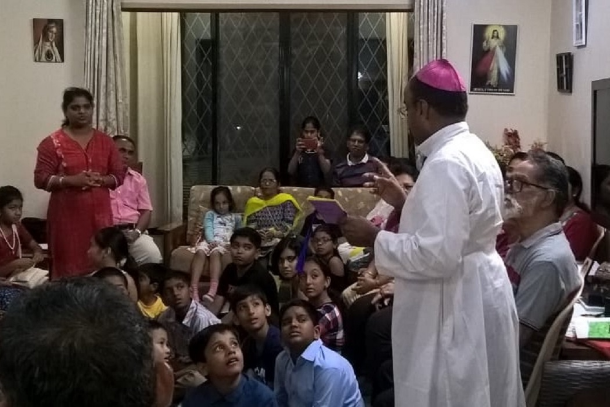Benny D’Souza remembers good past times at Christmas when he enjoyed a week of sumptuous meals and quality time in India’s western Pune city with a local Christian Mascarenhas family that traces its roots to Portuguese missioners.”We were poor and the parish organized that I have lunch and spend the evening with the Mascarenhas family, and come home for the night,” said D’Souza, 55, father of a son and daughter.”The daily visits for a week made me feel on top of the world.”The help came as part of the Small Christian Community (SCC) activities of the Immaculate Conception Church in Poona Diocese. Poona is the former name of Pune.The growth of such communities across India helps narrow a rich-poor divide, and caste-based discrimination, in hundreds of village parishes, a group of Indian bishops recently explained.
For example, Archbishop Anil Joseph Couto of Delhi noted that in Poona Diocese rich and influential people mingle with others who are poor and not so well educated.He added that the social divide seen among Catholics of high caste and lower caste elsewhere did not exist in this diocese.Archbishop Couto was among 41 bishops and four archbishops, who met Sept. 17-20 for a bishops’ colloquium on Small Christian Communities. The theme was: ‘Bishops are builders of communities to re-vitalize the Church’.The bishops met and interacted with families and various groups in several parishes of the diocese.Marina Colasco, a parish council member of St. Patrick’s Cathedral, told ucanews.com the small communities in their parish are active.”We are consolidating our small groups of families by visiting homes and by organizing frequent get-togethers and meetings for prayers and fellowship,” she said.The diocesan community consists of three ethnically different linguistic groups speaking Konkani, Marathi and Hindi. “But our group has broken the barrier of language and people of different languages mingle with each other easily,” she said.”We have now identified a couple of poor Catholic families who are provided regular rations of groceries by some donors in the group.”Sujata Rego, an area leader at St. Patrick’s Cathedral, said the SCCs have led Catholic families to read the Bible more often and reflect on it and also to reach out to disadvantaged families.”In fact, our group reaches out to two other not-so-well-off parishes to help them in every way, including providing tuition fees for needy students,” Rego said.Bishop Ignatius Mascarenhas of Simla-Chandigarh, chairman of the National Service Team for SCCs at the Indian Bishops’ conference, was among those who toured the diocese.”Many bishops met families directly and were touched by how ‘Small Christian Communities’ had taken root in this diocese,” he said.Bishop Mascarenhas explained SCCs as “the miniature church, the central force, without which the Sunday Mass congregation is meaningless.””Unless you are sent forth and live the rest of the week with your neighbors and spread love and forgiveness, our Sunday Mass congregation will be meaningless,” Bishop Mascarenhas said. “The SCCs are a springboard for action to bridge the differences of wealth, education, language, culture and caste,” he said.India’s 28 million Christians, who form some 2.3 percent of the 1.2 billion population, are of diverse ethnic backgrounds with around 60 percent of them coming from socially poor Dalit and tribal backgrounds.Within parishes, Catholics were mindful of economic and social status differences, but with the formation of SCCs, this was changing, Bishop Mascarenhas said.For example, a rich woman in a parish refused to be part of the local SCC until her husband had a heart attack. “After SSC members reached out to help her, she made SCCs her second home,” he said.Similarly, Father Thomas Vijay, national coordinator of the SCC program, said a Catholic mother and daughter lived happily in Delhi without being part of it until the mother was involved in a road accident.”Nobody visited her in the hospital,” he said. “But we alerted the SCCs in that area and the duo were overjoyed with the visits of SCC members and now both are active members.”Father Vijay said the SCCs aimed at achieving a communion of communities based on the Word of God and the Eucharist, leading to life in abundance and transforming society.Bishop Mascarenhas said the future of the church in India was to build communities on the pillars of liberty, equality, fraternity and justice.In 1990, the Indian Bishops’ Laity Commission, with Father Thomas Vijay as its secretary began the promotion of SCCs.Currently, 86,000 of them are spread across India’s 174 dioceses.”If all these communities are well trained to fight for our rights, we can be a formidable force,” Bishop Mascarenhas said.Careful planning was needed to use these well-knit communities to connect with people of local neighborhoods to become a tool for nation building, Bishop Mascarenhas said.This came at a significant point in India’s history when sectarian ideologues are promoting hatred against religious and ethnic minorities.People needed to understand the political and social implications of the “Kingdom vision” of Jesus for the world, the prelate said.



